Analysis of Potential Rockfalls on a Highway at High Slopes in Cold-Arid Areas (Northwest Xinjiang, China)
Abstract
:1. Introduction
2. Geologic Setting of the Study Area
3. Engineering Geology of the Study Area
4. Results and Discussion
4.1. Potential Rockfall Initial Position
4.2. Rockfall Mass Selection
4.3. Rockfall Simulations
4.4. Rockfall Influence Area Zonation
5. Conclusions
Acknowledgments
Author Contributions
Conflicts of Interest
References
- Ritchie, A.M. Evaluation of rockfall and its control. J. Exp. Psychol. Appl. 1963, 2, 291–304. [Google Scholar]
- Matsuoka, N.; Sakai, H. Rockfall activity from an alpine cliff during thawing periods. Geomorphology 1999, 28, 309–328. [Google Scholar] [CrossRef]
- Marzorati, S.; Luzi, L.; Amicis, M.D. Rock falls induced by earthquakes: A statistical approach. Soil Dyn. Earthq. Eng. 2002, 22, 565–577. [Google Scholar] [CrossRef]
- Dorren, L.K.A. A review of rockfall mechanics and modelling approaches. Prog. Phys. Geogr. 2003, 27, 69–87. [Google Scholar] [CrossRef]
- Flageollet, J.C.; Weber, D. Fall. In Landslide Recognition; Dikau, R., Brunsden, D., Schrott, L., Ibsen, M.L., Eds.; Wiley: Chichester, UK, 1996; pp. 13–28. [Google Scholar]
- Abebe, B.; Dramis, F.; Fubelli, G.; Umer, M.; Asrat, A. Landslides in the Ethiopian highlands and the Rift margins. J. Afr. Earth Sci. 2010, 56, 131–138. [Google Scholar] [CrossRef]
- Sassa, K.; Tsuchiya, S.; Ugai, K.; Wakai, A.; Uchimura, T. Landslides: A review of achievements in the first 5 years (2004–2009). Landslides 2009, 6, 275–286. [Google Scholar] [CrossRef]
- Ulusay, R.; Gokceoglu, C.; Topal, T.; Sonmez, H.; Tuncay, E.; Erguler, Z.A.; Kasmer, O. Assessment of environmental and engineering geological problems for the possible re-use of an abandoned rock-hewn settlement in Urgup (Cappadocia), Turkey. Environ. Geol. 2006, 50, 473–494. [Google Scholar] [CrossRef]
- Tunusluoglu, M.C.; Zorlu, K. Rockfall hazard assessment in a cultural and natural heritage (Ortahisar Castle, Cappadocia, Turkey). Environ. Geol. 2009, 56, 963–972. [Google Scholar] [CrossRef]
- Budetta, P. Assessment of rockfall risk along roads. Nat. Hazards Earth Syst. Sci. 2004, 4, 71–81. [Google Scholar] [CrossRef]
- Ansari, M.K.; Ahmad, M.; Singh, R.; Singh, T.N. Rockfall assessment near Saptashrungi Gad temple Nashik, Maharashtra, India. Int. J. Disaster Risk Reduct. 2012, 2, 77–83. [Google Scholar] [CrossRef]
- Palma, B.; Parise, M.; Reichenbach, P.; Guzzetti, F. Rockfall hazard assessment along a road in the Sorrento Peninsula Campania southern Italy. Nat. Hazards 2012, 61, 187–201. [Google Scholar] [CrossRef]
- Youssef, A.M.; Maerz, N.H.; Alotaibi, A.A. Stability of Rock Slopes along Raidah Escarpment Road, Asir Area, Kingdom of Saudi Arabia. J. Geogr. Geol. 2012, 4, 48–70. [Google Scholar] [CrossRef]
- Pappalardo, G.; Mineo, S.; Rapisarda, F. Rockfall hazard assessment along a road on the Peloritani Mountains (northeastern Sicily, Italy). Nat. Hazards Earth Syst. Sci. 2014, 14, 2735–2748. [Google Scholar] [CrossRef] [Green Version]
- Zhang, L.; Xu, B.; Shang, Y.; Zhu, J.; Yang, Z. Engineering geological investigation and assessment on rockfall hazard along Basu Linzhi section of south line of Sichuan-Tibet highway. Chin. J. Rock Mech. Eng. 2004, 23, l551–l557. [Google Scholar]
- Mineo, S.; Pappalardo, G.; Rapisarda, F.; Cubito, A.; Di Maria, G. Integrated geostructural, seismic and infrared thermography surveys for the study of an unstable rock slope in the Peloritani Chain (NE Sicily). Eng. Geol. 2015, 195, 225–235. [Google Scholar] [CrossRef]
- Pappalardo, G.; Mineo, S.; Zampelli, S.P.; Cubito, A.; Calcaterra, D. InfraRed Thermography proposed for the estimation of the Cooling Rate Index in the remote survey of rock masses. Int. J. Rock Mech. Min. 2016, 83, 182–196. [Google Scholar] [CrossRef]
- Yilmaz, I.; Yildirim, M.; Keskin, I. A method for mapping the spatial distribution of rockfall computer program analyses results using ArcGIS software. Bell. Eng. Geol. Environ. 2008, 67, 547–554. [Google Scholar] [CrossRef]
- Guzzetti, F.; Crosta, G.; Detti, R.; Agliardi, F. STONE: A computer program for the three-dimensional simulation of rock-falls. Comput. Geosci. 2002, 28, 1079–1093. [Google Scholar] [CrossRef]
- Jaboyedoff, M.; Labiouse, V. Technical Note: Preliminary estimation of rockfall runout zones. Nat. Hazards Earth Syst. Sci. 2011, 11, 819–828. [Google Scholar] [CrossRef] [Green Version]
- Li, L.; Lan, H. Probabilistic modeling of rockfall trajectories: A review. Bell. Eng. Geol. Environ. 2015, 74, 1163–1176. [Google Scholar] [CrossRef]
- Wang, G. Discussion on Designing and Reinforcing of High Man-Made Slopes. J. Gansu Sci. 2003, S1, 5–9. [Google Scholar]
- Chen, R.; Kang, E.; Wu, L.; Yang, J.; Ji, X.; Zhang, Z. Cold Regions in China. J. Glaciol. Geocryol. 2005, 4, 469–475. [Google Scholar] [CrossRef]
- Zhao, H.; Zhao, X.; Zhang, T.; Zhang, X.; Li, Y.; Liu, L. Desertification Process and Its Spatial Differentiation in Arid Areas of Northwest China. J. Desert Res. 2011, 1, 1–8. [Google Scholar]
- Gu, D. Rock Mass Structure. In Basis of Rock Engineering and Geomechanics; Zhou, W.F., Ed.; Science Press: Beijing, China, 1979; pp. 204–207. [Google Scholar]
- Barton, N.; Choubey, V. The shear strength of rock joints in theory and practice. Rock Mech. Rock Eng. 1977, 10, 1–54. [Google Scholar] [CrossRef]
- Zhou, X.Q.; Xu, W.Y.; Niu, X.Q.; Cui, Y.Z. A review of distinct element method researching progress and application. Rock Soil Mech. 2007, 28, 408–416. [Google Scholar]
- Pappalardo, G. Correlation between P-Wave Velocity and Physical–Mechanical Properties of Intensely Jointed Dolostones, Peloritani Mounts, NE Sicily. Rock Mech. Rock Eng. 2015, 48, 1711–1721. [Google Scholar] [CrossRef]
- Lang, Q.L. Prediction Research of Collapse and Landslide Caused by Volcanic Eruption in Changbai Mountains. Ph.D. Thesis, Jilin University, Changchun, China, 2014; p. 68. [Google Scholar]
- Palmstrom, A. Measurements of and correlations between block size and rock quality designation (RQD). Tunn. Undergr. Space Technol. 2005, 20, 362–377. [Google Scholar] [CrossRef]
- Okura, Y.; Kitahara, H.; Sammori, T.; Kawanami, A. The effects of rockfall volume on runout distance. Eng. Geol. 2000, 58, 109–124. [Google Scholar] [CrossRef]
- Vijayakumar, S.; Yacoub, T.; Curran, J.H. On the Effect of Rock Size and Shape in Rockfall Analyses. 1996. Available online: https://www.rocscience.com/documents/pdfs/library/Effect-of-Rock-Size-on-Rocfall-Analysis.pdf (accessed on 9 March 2017).
- Evans, S.G.; Hungr, O. The assessment of rockfall hazard at the base of talus slopes. Can. Geotech. J. 1993, 30, 620–636. [Google Scholar] [CrossRef]
- Azzoni, A.; Barbera, G.L.; Zaninetti, A. Analysis and Prediction of Rockfalls Using a Mathematical Model. Int. J. Rock Mech. Min. Sci. Geomech. Abstr. 1995, 32, 709–724. [Google Scholar] [CrossRef]
- Dorren, L.K.A.; Berger, F.; Putters, U.S. Real-size Experiments and 3-D Simulation of Rockfall on Forested and non-forested Slopes. Nat. Hazards Earth Syst. Sci. 2006, 6, 145–153. [Google Scholar] [CrossRef]
- Asteriou, P.; Saroglou, H.; Tsiambaos, G. Geotechnical and kinematic parameters affecting the coefficients of restitution for rock fall analysis. Int. J. Rock Mech. Min. 2012, 54, 103–113. [Google Scholar] [CrossRef]
- Giacomini, A.; Buzzi, O.; Renard, B.; Giani, G.P. Experimental studies on fragmentation of rock falls on impact with rock surfaces. Int. J. Rock Mech. Min. 2009, 46, 708–715. [Google Scholar] [CrossRef]
- Budetta, P.; Santo, A. Morphostructural evolution and related kinematics of rockfalls in Campania (southern Italy): A case study. Eng. Geol. 1994, 36, 197–210. [Google Scholar] [CrossRef]
- Kobayashi, Y.; Harp, E.L.; Kagawa, T. Simulation of rockfalls triggered by earthquakes. Rock Mech. Rock Eng. 1990, 23, 1–20. [Google Scholar] [CrossRef]
- Chau, K.T.; Wong, R.H.C.; Wu, J.J. Coefficient of restitution and rotational motions of rockfall impacts. Int. J. Rock Mech. Min. 2002, 39, 69–77. [Google Scholar] [CrossRef]
- Youssef, A.M.; Pradhan, B.; Al-Kathery, M.; Bathrellos, G.D.; Skilodimou, H.D. Assessment of rockfall hazard at Al-Noor Mountain, Makkah city (Saudi Arabia) using spatio-temporal remote sensing data and field investigation. J. Afr. Earth Sci. 2015, 101, 309–321. [Google Scholar] [CrossRef]
- Liu, H.M. Research on the Motion Trajectory of Rockfall in Tianchi Lake Area of Changbai Mountain Longmen Peak. Master’s Thesis, Jilin University, Changchun, China, 2012; p. 83. [Google Scholar]
- Schweigl, J.; Ferretti, C.; NÖssing, L. Geotechnical characterization and rockfall simulation of a slope: A practical case study from South Tyrol (Italy). Eng. Geol. 2003, 67, 281–296. [Google Scholar] [CrossRef]
- Corominas, J.; Copons, R.; Moya, J.; Vilaplana, J.M.; Altimir, J.; Amigó, J. Quantitative assessment of the residual risk in a rockfall protected area. Landslides 2005, 2, 343–357. [Google Scholar] [CrossRef]
- Topal, T.; Akin, M.; Ozden, U.A. Assessment of rockfall hazard around Afyon Castle, Turkey. Environ. Geol. 2007, 53, 191–200. [Google Scholar] [CrossRef]
- Volkwein, A.; Schellenberg, K.; Labiouse, V.; Agliardi, F. Rockfall characterization and structural protection—A review. Nat. Hazards Earth Syst. Sci. 2011, 11, 2617–2651. [Google Scholar] [CrossRef] [Green Version]
- Perret, S.; Dolf, F.; Kienholz, H. Rockfalls into forests: Analysis and simulation of rockfall trajectories—Considerations with respect to mountainous forests in Switzerland. Landslides 2004, 1, 123–130. [Google Scholar] [CrossRef]
- Wang, X.L.; Zhang, L.Q.; Wang, S.J.; Agliardi, F.; Frattini, P.; Crosta, G.B.; Yang, Z.F. Field investigation and rockfall hazard zonation at the Shijing Mountains Sutra caves cultural heritage (China). Environ. Earth Sci. 2012, 66, 1897–1908. [Google Scholar] [CrossRef]
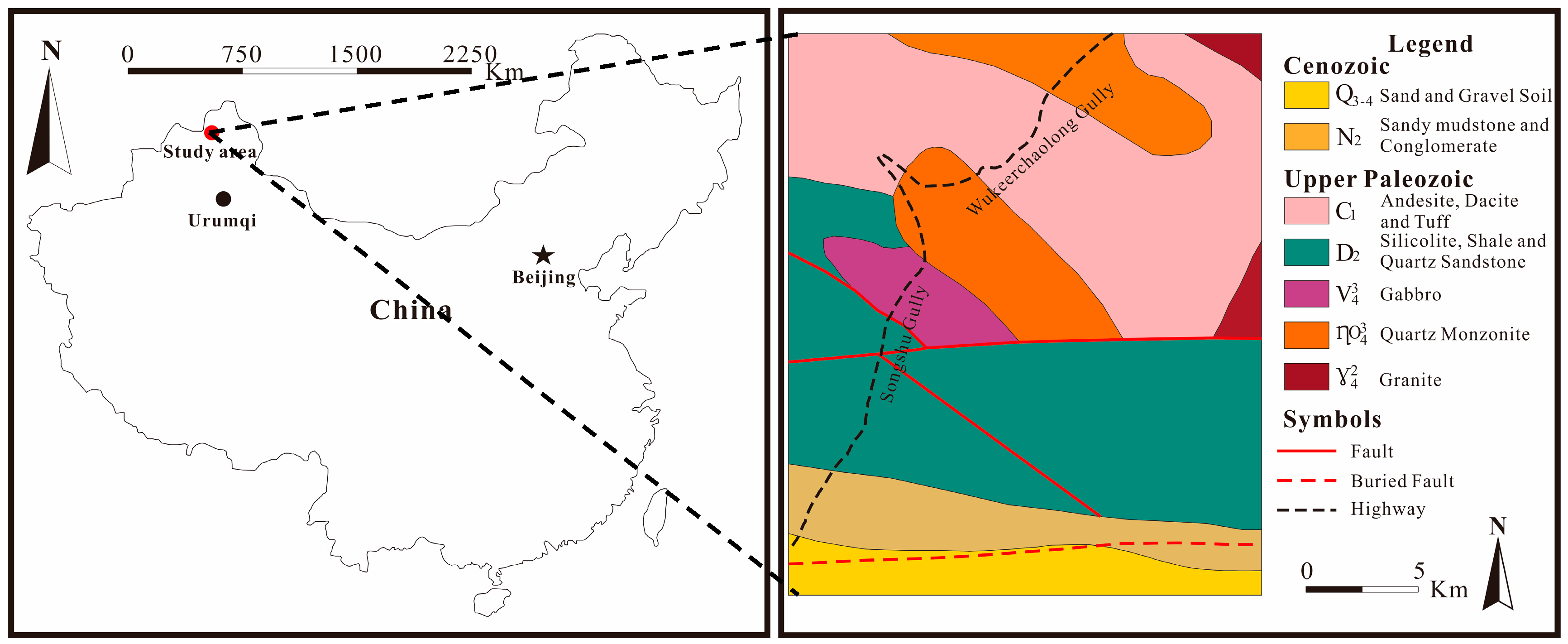
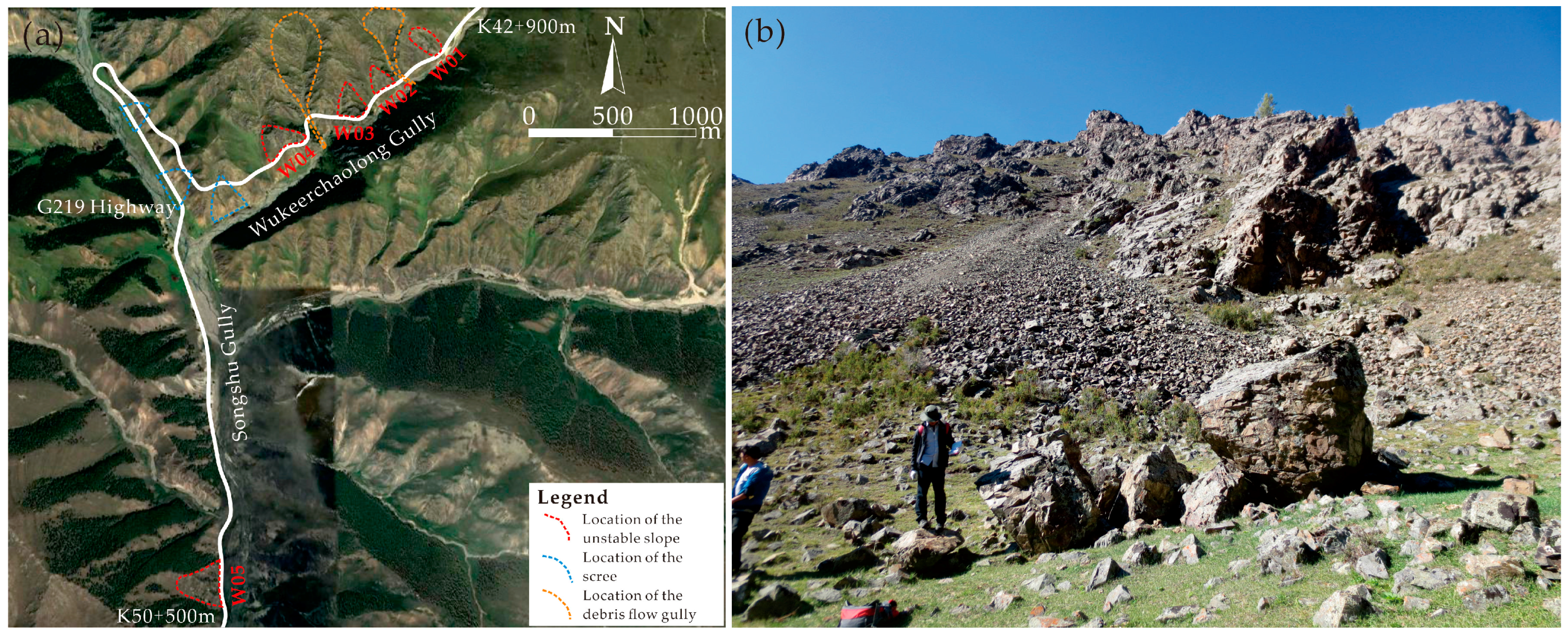

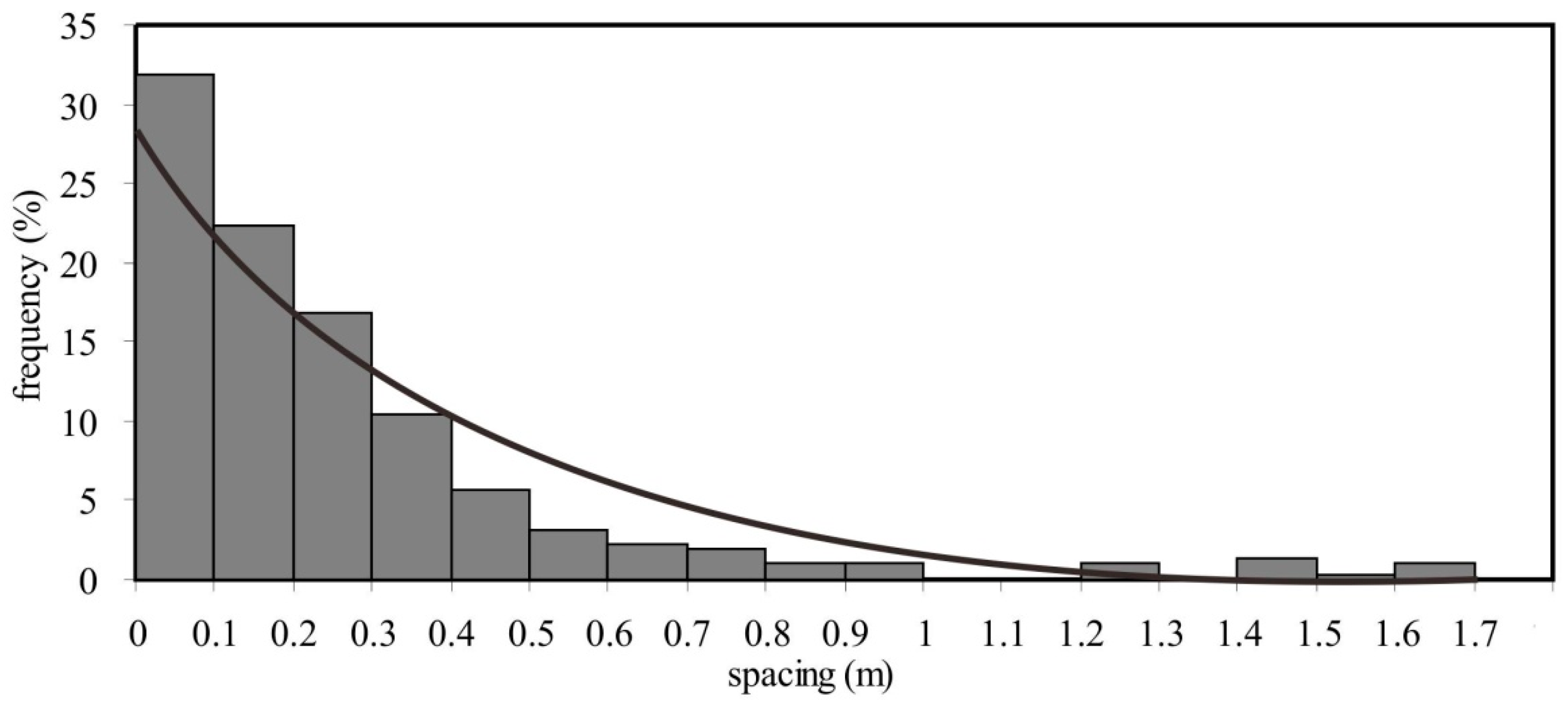
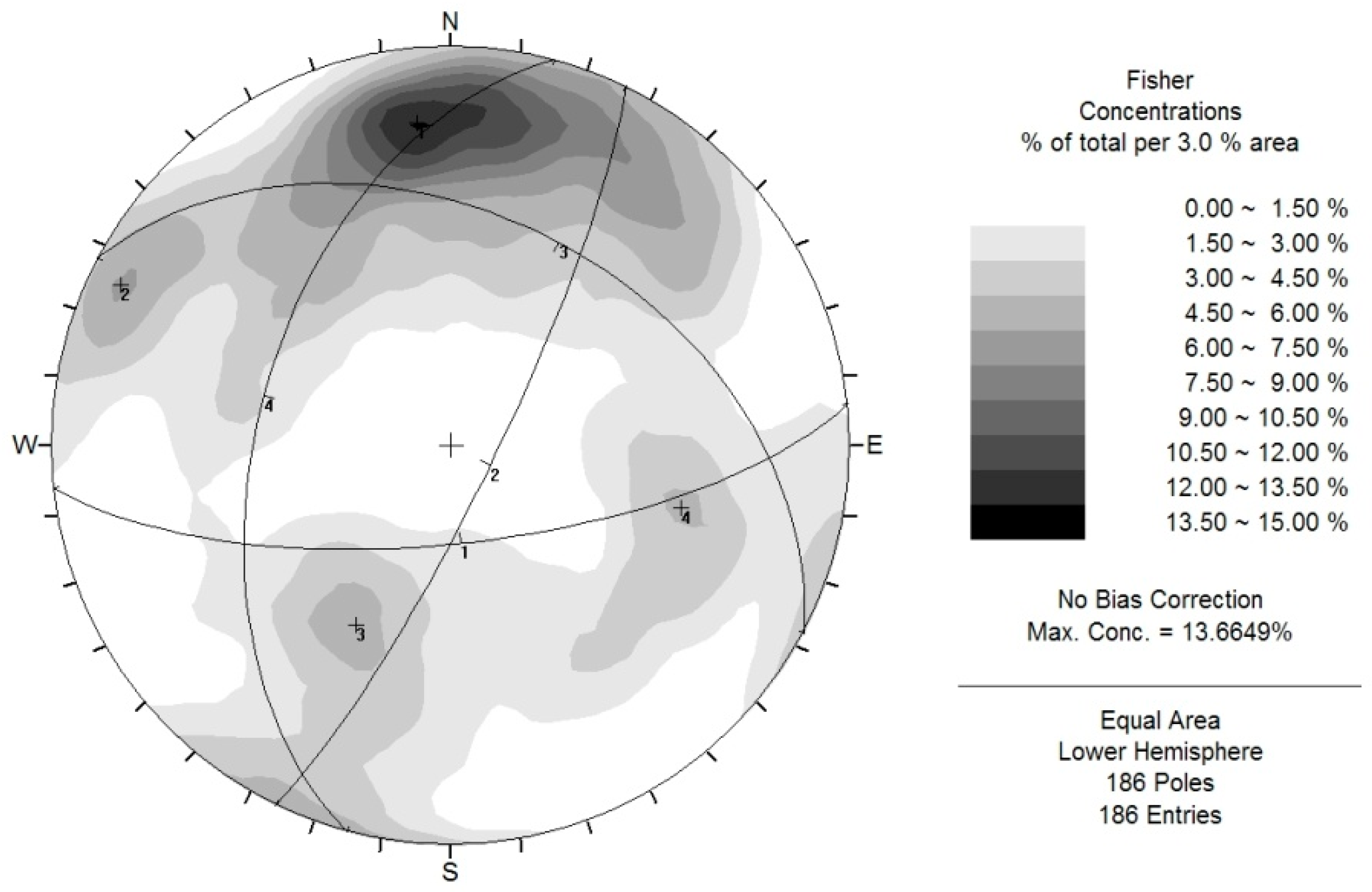
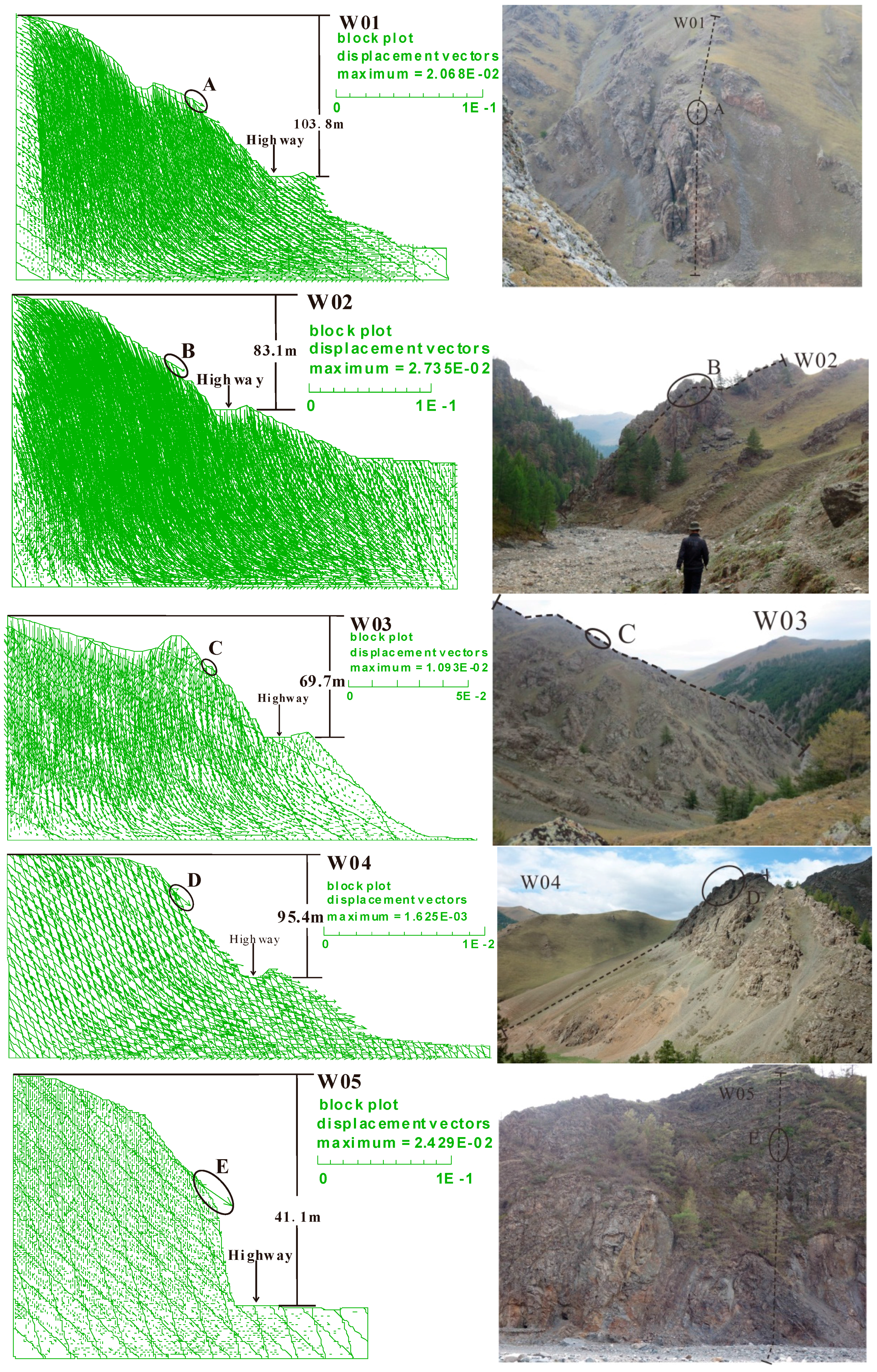
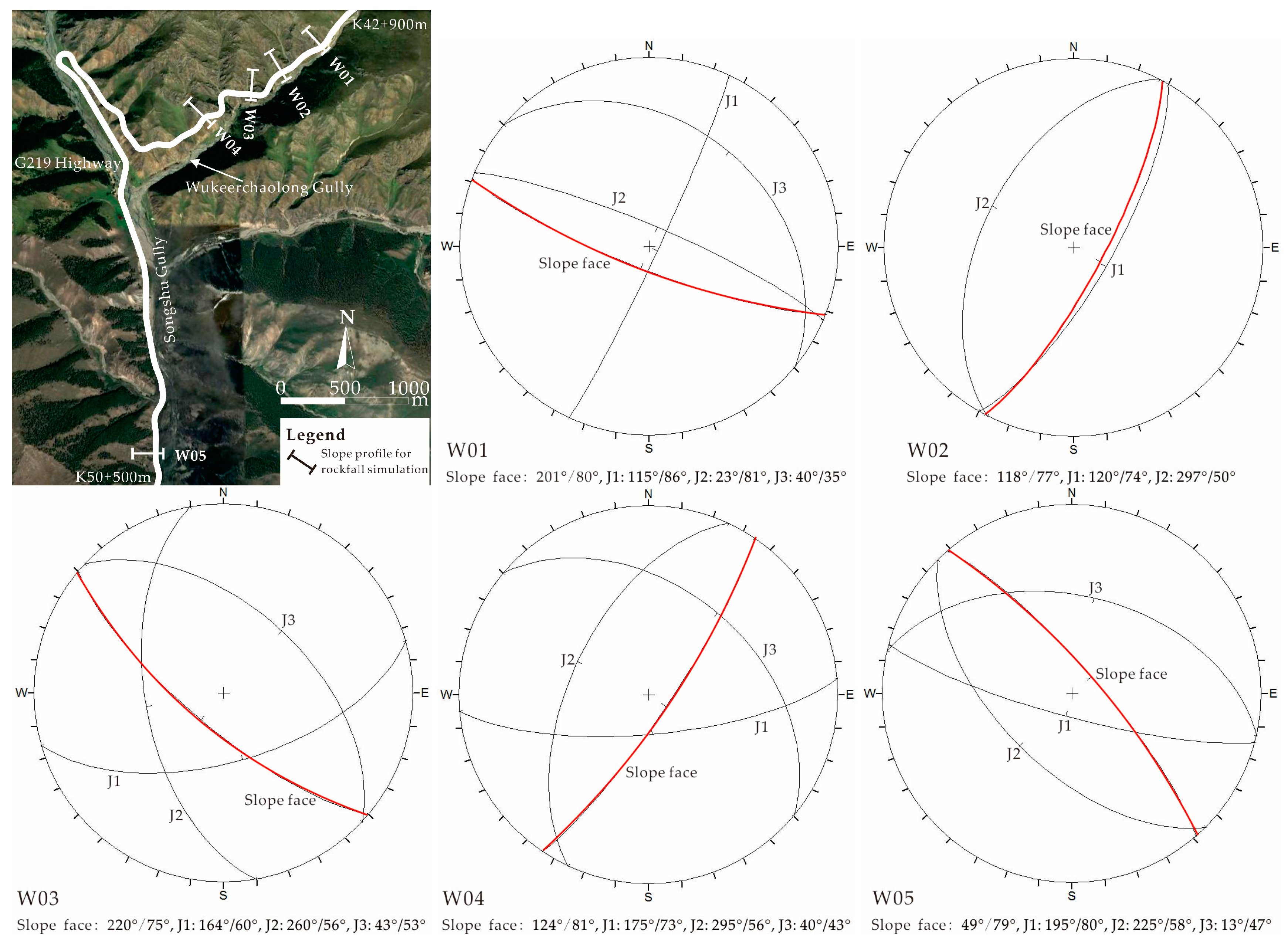
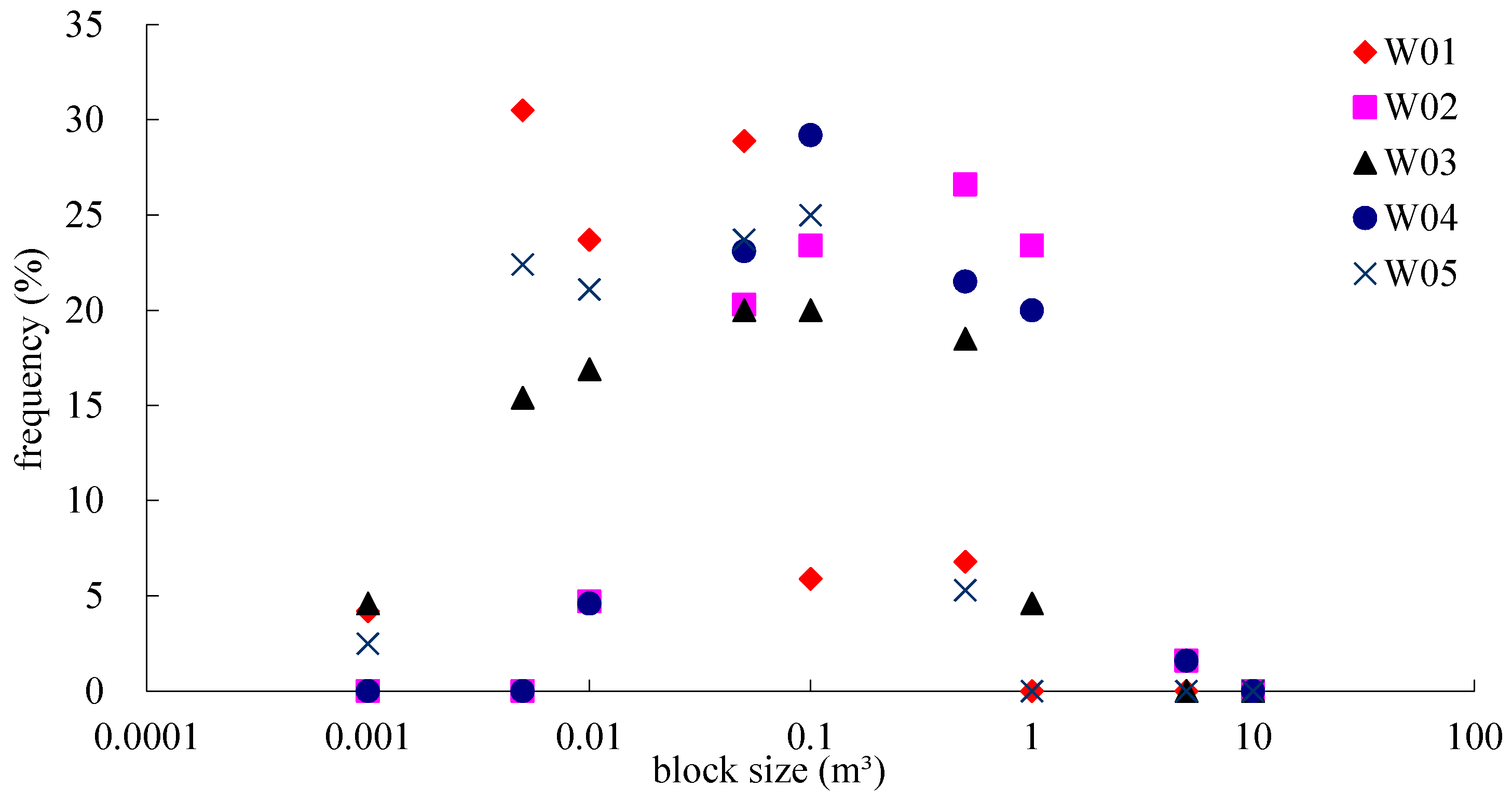
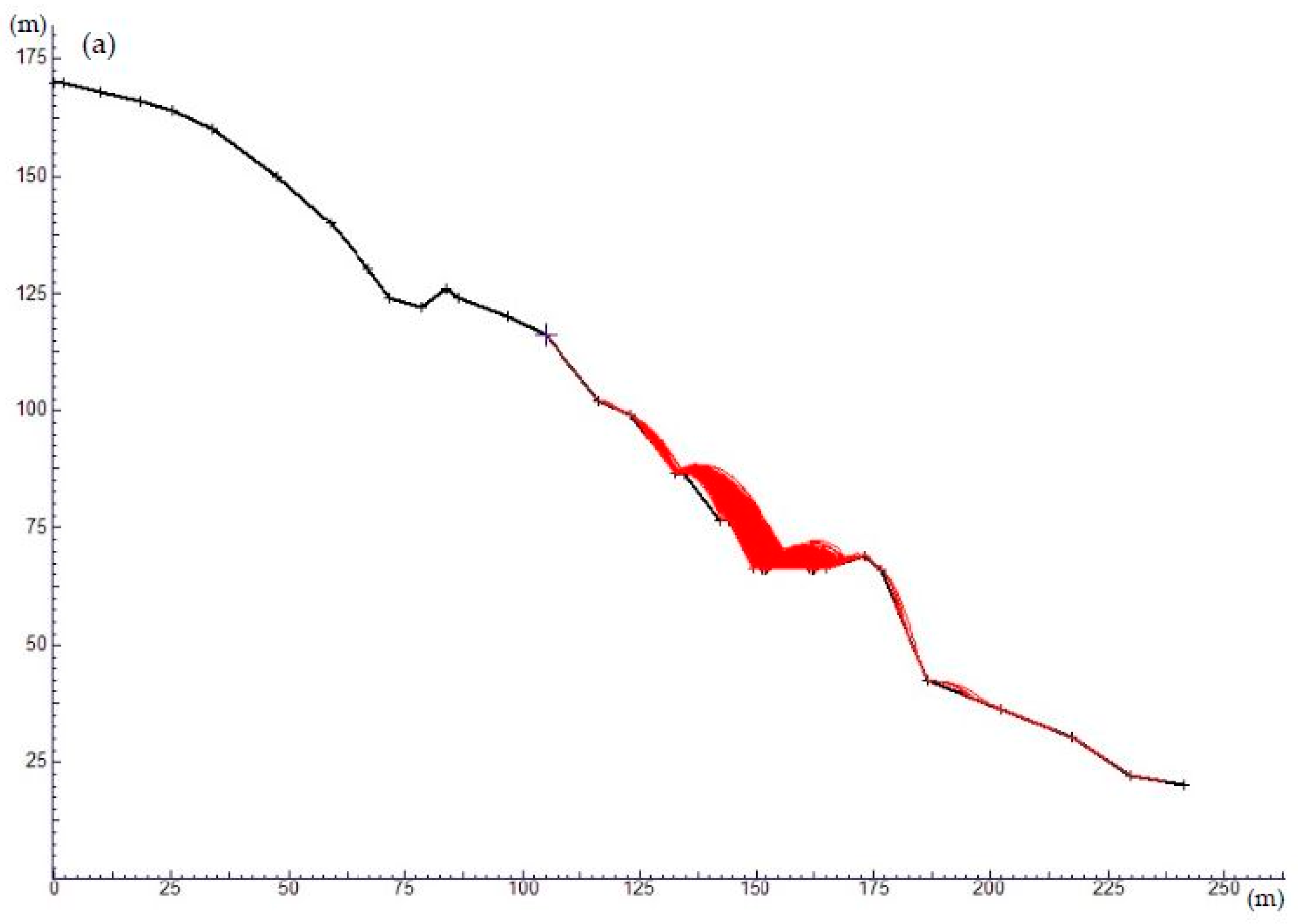
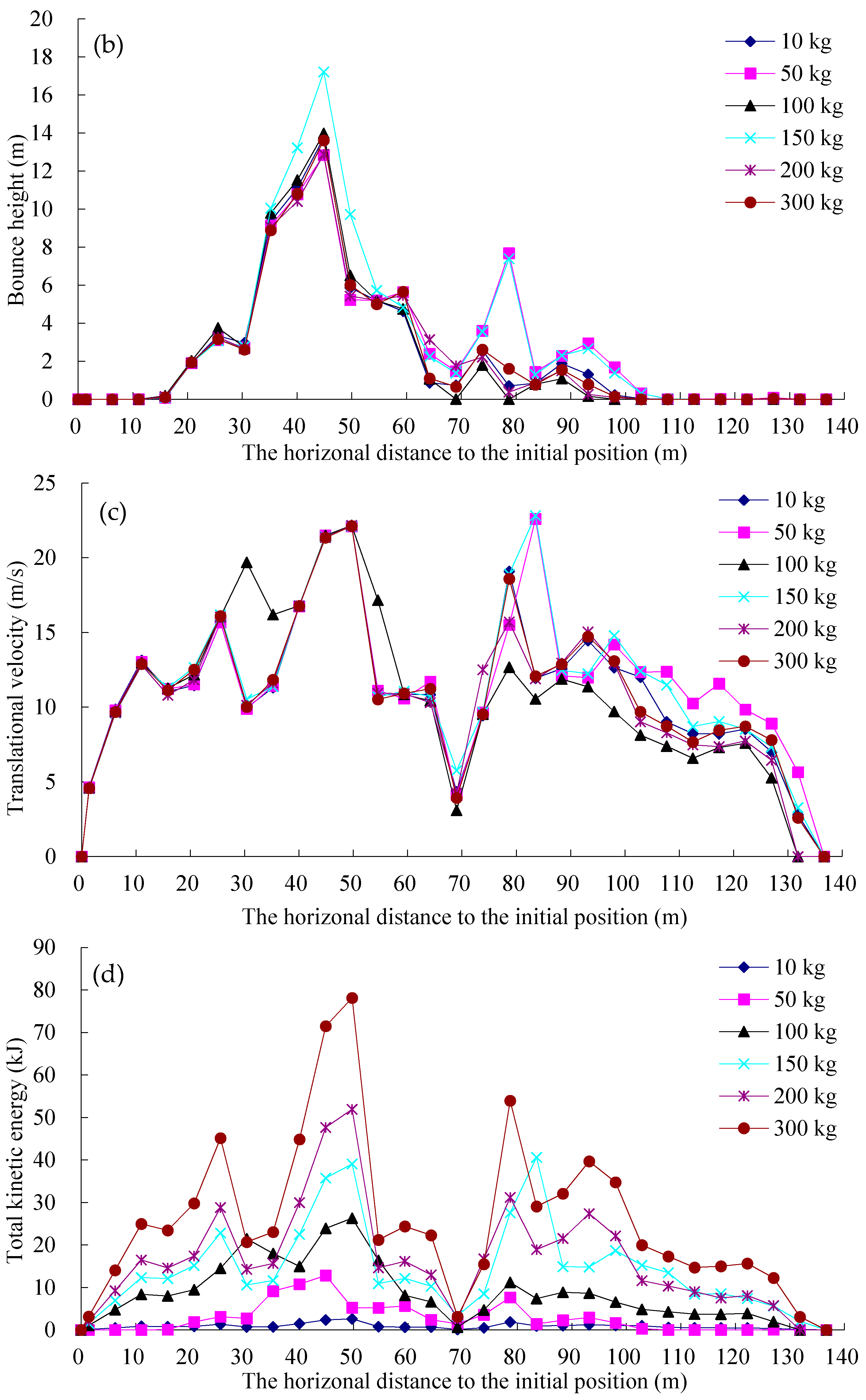
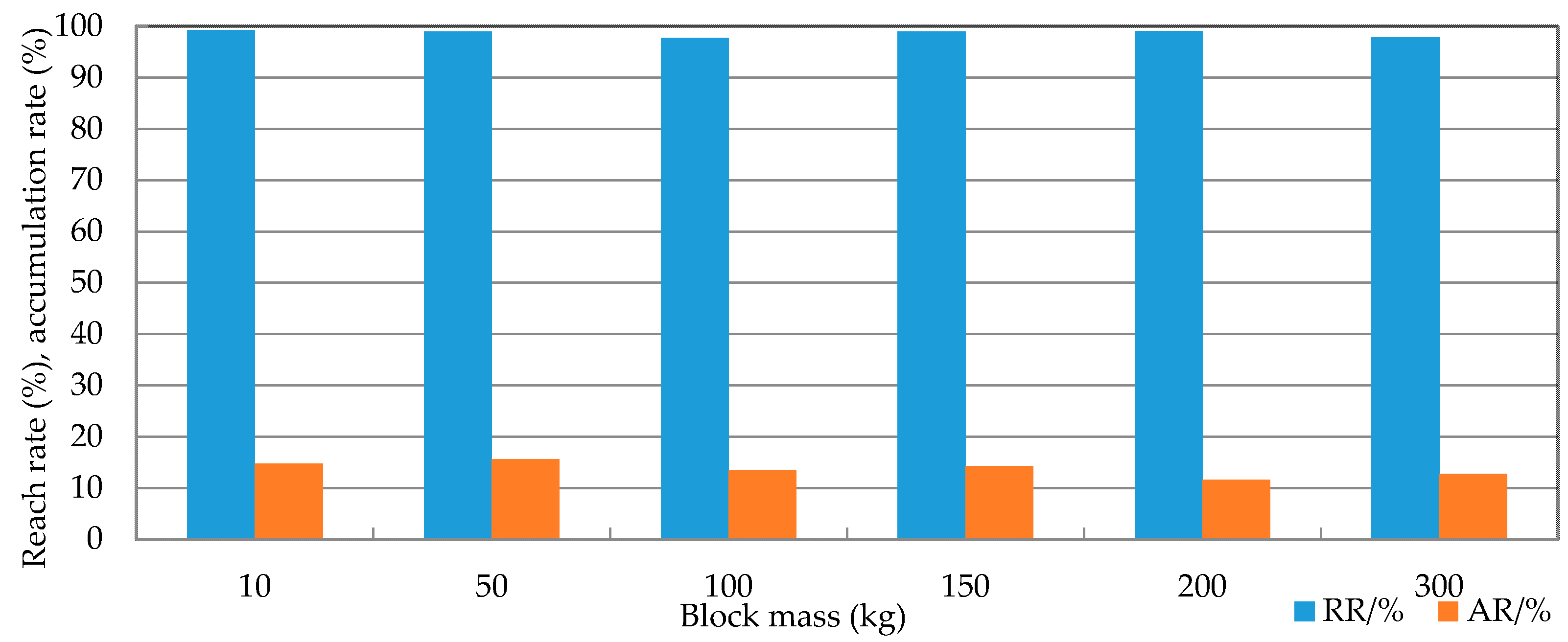
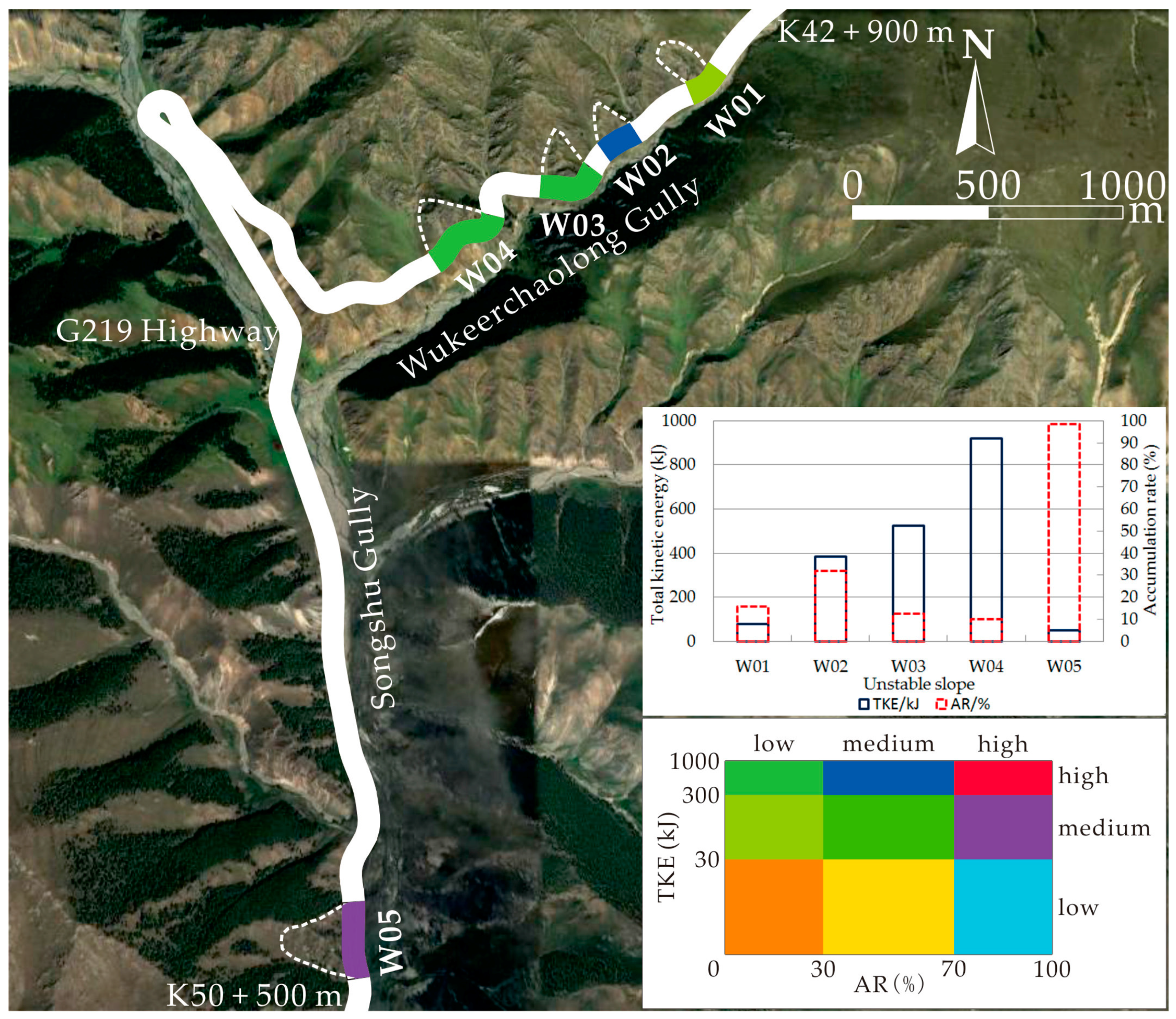
| No. | Corresponding Mileage | Altitude (m) | Lithology | Rock Mass Structure | Slope Structure | Failure Mode | Volume (m3) |
|---|---|---|---|---|---|---|---|
| W01 | K43 + 120 ~ K43 + 220 m | 2157 | Granite | Mosaic | Insequent | Toppling | 31,758 |
| W02 | K43 + 600 ~ K43 + 672 m | 2158 | Andesite | Mosaic | Dip | Sliding | 23,520 |
| W03 | K43 + 900 ~ K43 + 980 m | 2138 | Andesite | Mosaic | Dip | Wedge | 43,000 |
| W04 | K44 + 520 ~ K44 + 640 m | 2095 | Dacite | Mosaic | Dip | Wedge | 13,772 |
| W05 | K50 + 152 ~ K50 + 366 m | 1914 | Silicolite | Mosaic | Insequent | Toppling | 43,125 |
| No. | Set Number | Average Attitude | Persistence (m) | Spacing (m) | JRC | Type | Weathering |
|---|---|---|---|---|---|---|---|
| W01 | J1 | 115°/86° | 15–20 | 0.4–1.3 | 13 | Unloading | Moderately |
| J2 | 23°/81° | 9–12 | 0.3–0.4 | 7 | Tectonic | Slightly | |
| J3 | 40°/35° | 4–6 | 0.3–0.4 | 6 | Tectonic | Moderately | |
| W02 | J1 | 120°/74° | 8–12 | 0.3–1.0 | 9 | Unloading | Slightly |
| J2 | 297°/50° | 2–4 | 0.3–0.5 | 7 | Tectonic | Moderately | |
| W03 | J1 | 164°/60° | 4–5 | 0.5–1.0 | 7 | Tectonic | Moderately |
| J2 | 260°/56° | 5–7 | 0.6–1.5 | 6 | Tectonic | Slightly | |
| J3 | 43°/53° | 2–6 | 0.2–0.3 | 5 | Tectonic | Moderately | |
| W04 | J1 | 175°/73° | 10–15 | 4.0–5.0 | 7 | Unloading | Slightly |
| J2 | 295°/56° | 2–5 | 0.2–0.5 | 9 | Tectonic | Moderately | |
| J3 | 40°/43° | 4–6 | 0.2–0.5 | 6 | Tectonic | Moderately | |
| W05 | J1 | 195°/80° | 15–25 | 5.0–8.0 | 15 | Tectonic | Moderately |
| J2 | 225°/58° | 5–8 | 0.4–0.8 | 8 | Tectonic | Slightly | |
| J3 | 13°/47° | 4–6 | 0.2–0.5 | 7 | Tectonic | Moderately |
| Property | W01 | W02 | W03 | W04 | W05 | |
|---|---|---|---|---|---|---|
| Rock | Number of specimen | 5 | 5 | 5 | 5 | 5 |
| Lithology of specimen | Granite | Andesite | Andesite | Dacite | Silicolite | |
| Density (g/cm3) | 2.85 | 2.65 | 2.65 | 2.63 | 2.75 | |
| Cohesion (MPa) | 2.5 | 1.9 | 1.9 | 1.6 | 1.9 | |
| Friction angle (°) | 45 | 43 | 43 | 42 | 41 | |
| Elasticity modulus(GPa) | 25 | 23 | 23 | 20 | 9 | |
| Poisson’s ratio | 0.25 | 0.24 | 0.24 | 0.23 | 0.22 | |
| Joint | Cohesion (MPa) | 0.48 | 0.23 | 0.23 | 0.15 | 0.43 |
| Friction angle (°) | 35 | 32 | 32 | 30 | 35 | |
| Normal stiffness (GPa/m) | 16.9 | 15.6 | 15.6 | 12.0 | 11.4 | |
| Tangential stiffness (GPa/m) | 7.5 | 6.3 | 6.3 | 5.0 | 4.4 | |
| No. | Size Range (m3) | Density (g/cm3) | Representative Values (kg) | |||||
|---|---|---|---|---|---|---|---|---|
| M1 | M2 | M3 | M4 | M5 | M6 | |||
| W01 | 0.005–0.100 | 2.85 | 10 | 50 | 100 | 150 | 200 | 300 |
| W02 | 0.010–1.000 | 2.65 | 50 | 100 | 500 | 1000 | 2000 | 2500 |
| W03 | 0.005–0.500 | 2.65 | 10 | 50 | 100 | 500 | 1000 | 1500 |
| W04 | 0.050–1.000 | 2.63 | 100 | 500 | 1000 | 1500 | 2000 | 2500 |
| W05 | 0.005–0.100 | 2.75 | 10 | 50 | 100 | 150 | 200 | 300 |
| Authors | Material Type | Rt | Rn |
|---|---|---|---|
| Liu (2012) | Hard surface paving | 0.87–0.92 | 0.37–0.42 |
| Bedrock or boulders with little soil or vegetation | 0.83–0.87 | 0.33–0.37 | |
| Talus with little vegetation | 0.83–0.87 | 0.30–0.33 | |
| Talus with some vegetation | 0.80–0.83 | 0.30–0.33 | |
| Soft soil slope with little vegetation | 0.80–0.83 | 0.28–0.32 | |
| Vegetated soil slope | 0.78–0.82 | 0.28–0.32 | |
| Schweil et al. (2003) | Asphalt | 0.90 ± 0.04 | 0.40 ± 0.04 |
| Parameters | W01 | W02 | W03 | W04 | W05 | Asphalt |
|---|---|---|---|---|---|---|
| Number of rockfalls | 1000 | 1000 | 1000 | 1000 | 1000 | — |
| Coefficient of normal restitution | 0.37 ± 0.03 | 0.34 ± 0.03 | 0.34 ± 0.03 | 0.33 ± 0.03 | 0.37 ± 0.03 | 0.40 ± 0.04 |
| Coefficient of tangential restitution | 0.87 ± 0.04 | 0.86 ± 0.04 | 0.86 ± 0.04 | 0.85 ± 0.04 | 0.87 ± 0.04 | 0.90 ± 0.04 |
| Rotational friction angle (°) | 30 ± 2 | 30 ± 2 | 30 ± 2 | 30 ± 2 | 30 ± 2 | 30 ± 2 |
| Surface roughness (°) | 2 | 2 | 2 | 2 | 2 | 2 |
| Initial velocity (m/s) | 0 | 0 | 0 | 0 | 0 | 0 |
| No. | HR (m) | BM (kg) | RD (m) | L (m) | BH (m) | L (m) | TV (m/s) | L (m) | TKE (kJ) | RR (%) | AR (%) |
|---|---|---|---|---|---|---|---|---|---|---|---|
| W01 | 46.2–57.8 | 10 | 44.2–133.0 | 44.9 | 13.75 | 49.7 | 22.2 | 49.7 | 2.62 | 99.25 | 14.74 |
| 50 | 44.2–136.5 | 44.9 | 12.84 | 49.7 | 22.1 | 49.7 | 12.84 | 98.95 | 15.63 | ||
| 100 | 44.2–130.8 | 44.9 | 13.98 | 49.7 | 22.2 | 49.7 | 26.30 | 97.75 | 13.47 | ||
| 150 | 44.2–133.4 | 44.9 | 17.22 | 49.7 | 22.1 | 49.7 | 39.05 | 98.95 | 14.33 | ||
| 200 | 44.2–131.2 | 44.9 | 12.88 | 49.7 | 22.2 | 49.7 | 51.91 | 99.05 | 11.66 | ||
| 300 | 44.2–132.7 | 44.9 | 13.61 | 49.7 | 22.1 | 49.7 | 78.13 | 97.85 | 12.76 | ||
| W02 | 28.1–39.7 | 50 | 26.1–46.6 | 26.4 | 10.48 | 31.7 | 16.1 | 34.3 | 7.65 | 85.99 | 29.53 |
| 100 | 26.1–46.5 | 26.4 | 9.65 | 31.7 | 16.0 | 33.0 | 14.79 | 88.69 | 31.83 | ||
| 500 | 26.1–48.1 | 26.4 | 9.95 | 31.7 | 16.0 | 33.0 | 74.22 | 89.29 | 28.63 | ||
| 1000 | 26.1–47.1 | 26.4 | 10.29 | 31.7 | 16.1 | 34.3 | 156.36 | 87.69 | 27.53 | ||
| 2000 | 26.1–47.1 | 26.4 | 10.07 | 31.7 | 16.1 | 33.0 | 295.91 | 87.79 | 28.93 | ||
| 2500 | 26.1–46.8 | 26.4 | 10.06 | 31.7 | 16.0 | 34.3 | 383.77 | 88.29 | 30.13 | ||
| W03 | 42.2–53.8 | 10 | 40.1–62.8 | 40.0 | 13.13 | 42.4 | 26.0 | 42.4 | 3.51 | 98.60 | 9.41 |
| 50 | 40.1–61.9 | 40.0 | 12.94 | 42.4 | 25.9 | 42.4 | 17.43 | 98.20 | 12.51 | ||
| 100 | 40.1–63.3 | 40.0 | 12.91 | 42.4 | 26.0 | 42.4 | 34.88 | 98.30 | 11.41 | ||
| 500 | 40.1–63.3 | 40.0 | 12.86 | 42.4 | 26.0 | 42.4 | 175.49 | 99.40 | 10.91 | ||
| 1000 | 40.1–63.1 | 40.0 | 12.76 | 42.4 | 25.9 | 42.4 | 348.61 | 98.90 | 9.31 | ||
| 1500 | 40.1–63.4 | 40.0 | 13.02 | 42.4 | 25.9 | 42.4 | 525.52 | 99.20 | 11.11 | ||
| W04 | 50.8–62.4 | 100 | 48.6–64.6 | 49.4 | 18.81 | 39.5 | 26.1 | 39.5 | 36.47 | 99.90 | 9.41 |
| 500 | 48.6–64.6 | 49.4 | 19.27 | 39.5 | 26.3 | 39.5 | 184.72 | 99.60 | 10.01 | ||
| 1000 | 48.6–64.6 | 49.4 | 19.98 | 39.5 | 24.3 | 39.5 | 323.23 | 99.70 | 8.71 | ||
| 1500 | 48.6–64.6 | 49.4 | 19.25 | 39.5 | 24.1 | 39.5 | 478.44 | 99.60 | 8.41 | ||
| 2000 | 48.6–64.6 | 49.4 | 18.33 | 39.5 | 24.5 | 39.5 | 659.18 | 98.70 | 9.51 | ||
| 2500 | 48.6–64.6 | 49.4 | 18.09 | 39.5 | 26.3 | 39.5 | 920.78 | 99.00 | 8.91 | ||
| W05 | 7.2–18.8 | 10 | 11.2–20.4 | 1.32 | 4.42 | 3.0 | 15.8 | 3.0 | 1.65 | 100.0 | 98.60 |
| 50 | 10.4–21.2 | 1.32 | 4.44 | 3.0 | 16.1 | 3.0 | 8.51 | 100.0 | 96.00 | ||
| 100 | 11.7–20.8 | 1.32 | 4.42 | 3.0 | 16.0 | 3.0 | 16.86 | 100.0 | 93.49 | ||
| 150 | 10.8–20.5 | 1.32 | 4.42 | 3.0 | 15.9 | 3.0 | 25.17 | 100.0 | 97.70 | ||
| 200 | 10.5–20.5 | 1.32 | 4.38 | 3.0 | 16.0 | 3.0 | 33.92 | 100.0 | 96.20 | ||
| 300 | 11.8–21.2 | 1.32 | 4.41 | 3.0 | 15.8 | 3.0 | 49.31 | 100.0 | 97.00 |
© 2017 by the authors. Licensee MDPI, Basel, Switzerland. This article is an open access article distributed under the terms and conditions of the Creative Commons Attribution (CC BY) license ( http://creativecommons.org/licenses/by/4.0/).
Share and Cite
Yang, P.; Shang, Y.; Li, Y.; Wang, H.; Li, K. Analysis of Potential Rockfalls on a Highway at High Slopes in Cold-Arid Areas (Northwest Xinjiang, China). Sustainability 2017, 9, 414. https://doi.org/10.3390/su9030414
Yang P, Shang Y, Li Y, Wang H, Li K. Analysis of Potential Rockfalls on a Highway at High Slopes in Cold-Arid Areas (Northwest Xinjiang, China). Sustainability. 2017; 9(3):414. https://doi.org/10.3390/su9030414
Chicago/Turabian StyleYang, Peng, Yanjun Shang, Yanyan Li, Huilun Wang, and Kun Li. 2017. "Analysis of Potential Rockfalls on a Highway at High Slopes in Cold-Arid Areas (Northwest Xinjiang, China)" Sustainability 9, no. 3: 414. https://doi.org/10.3390/su9030414





